Remembering the fall of Singapore - papers of Charles Laurie Price 1942-1945
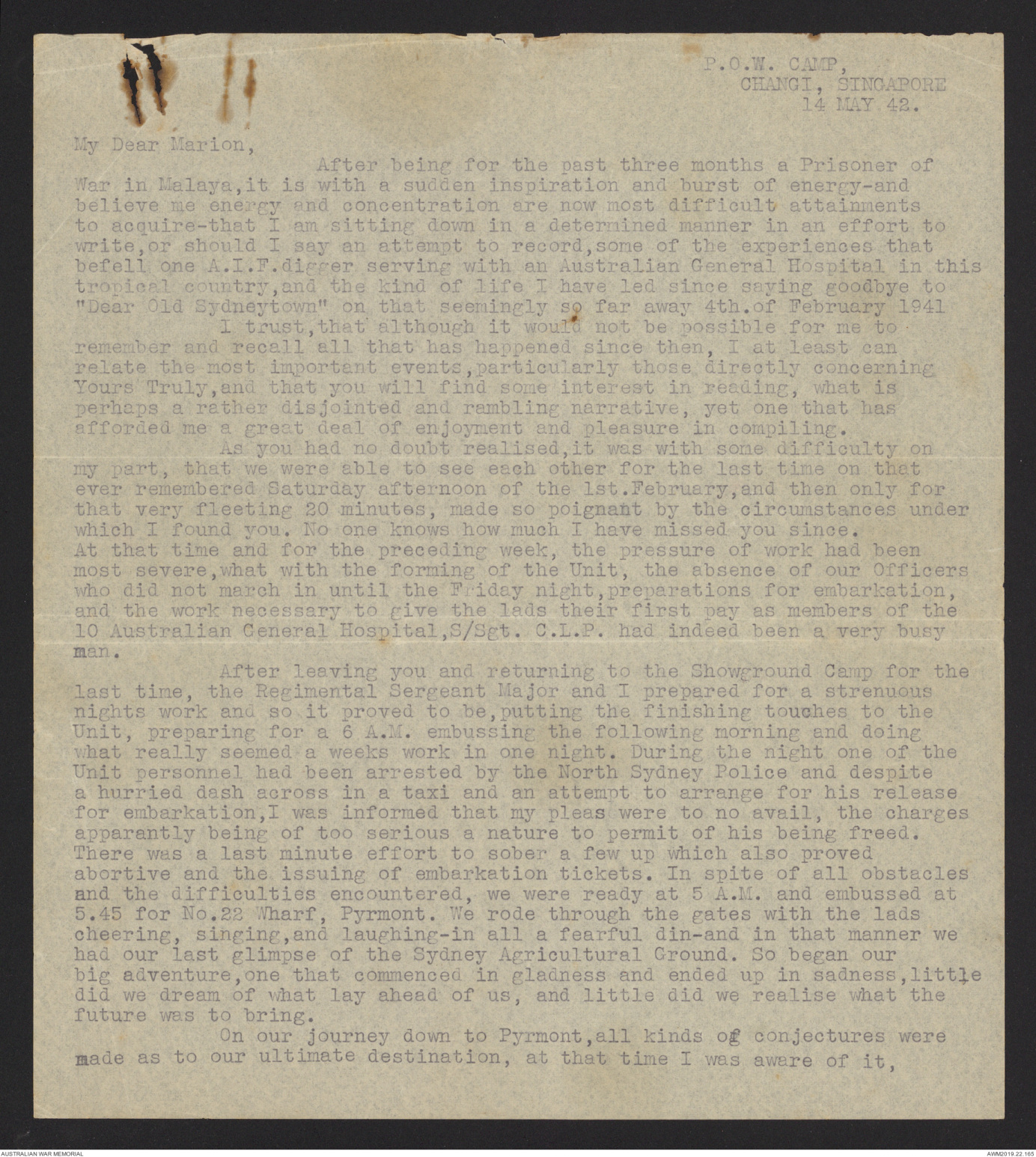
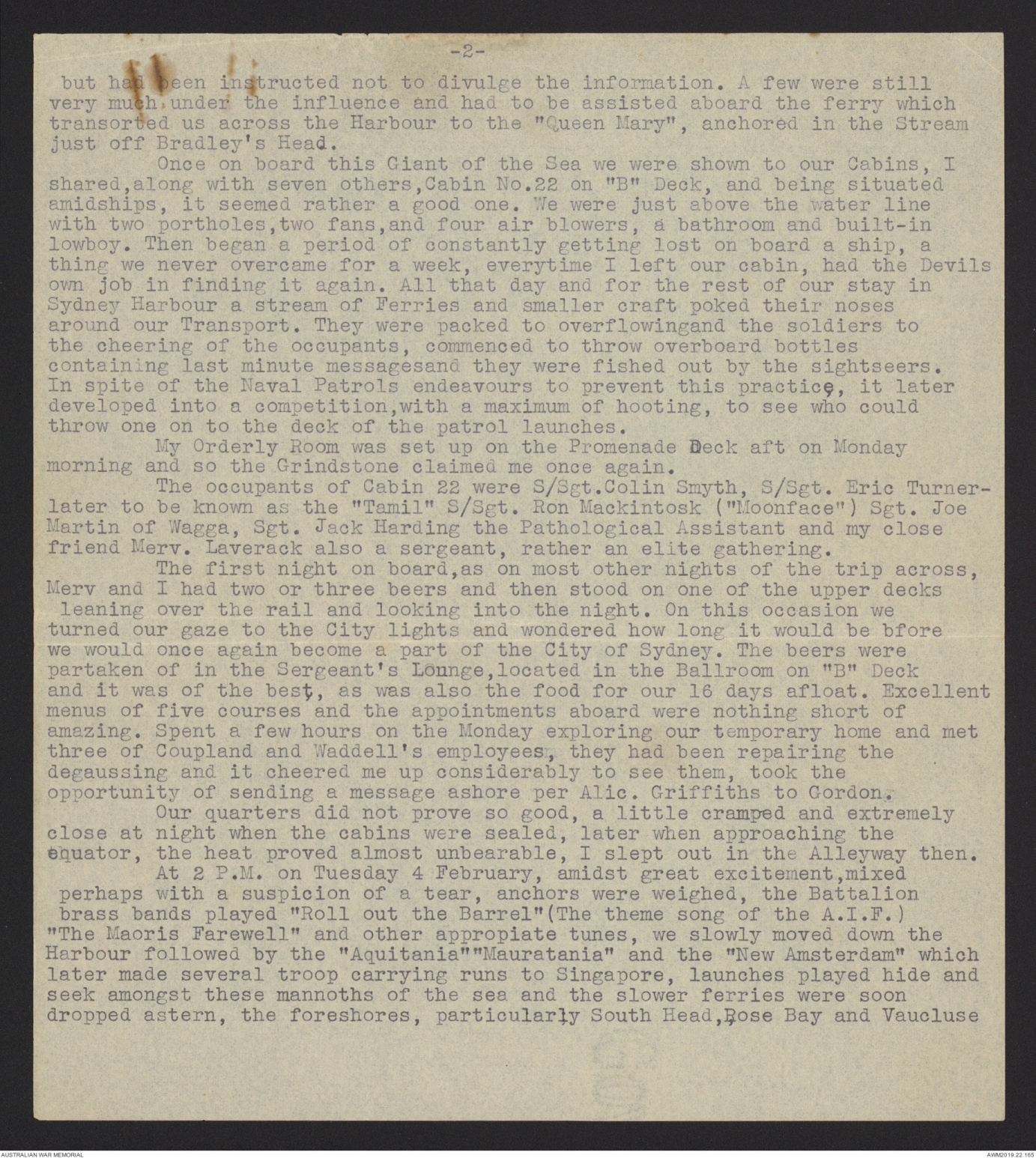
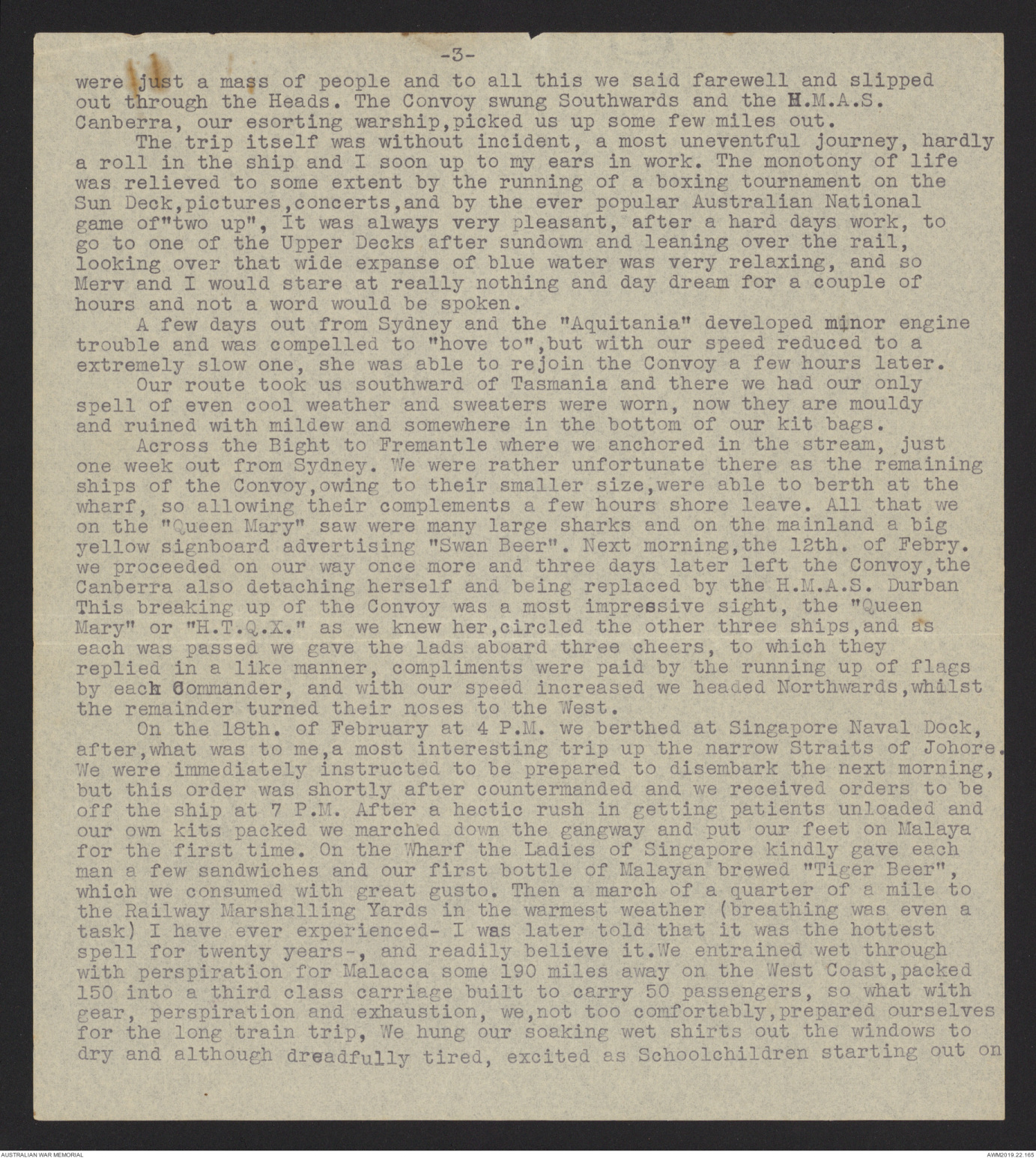
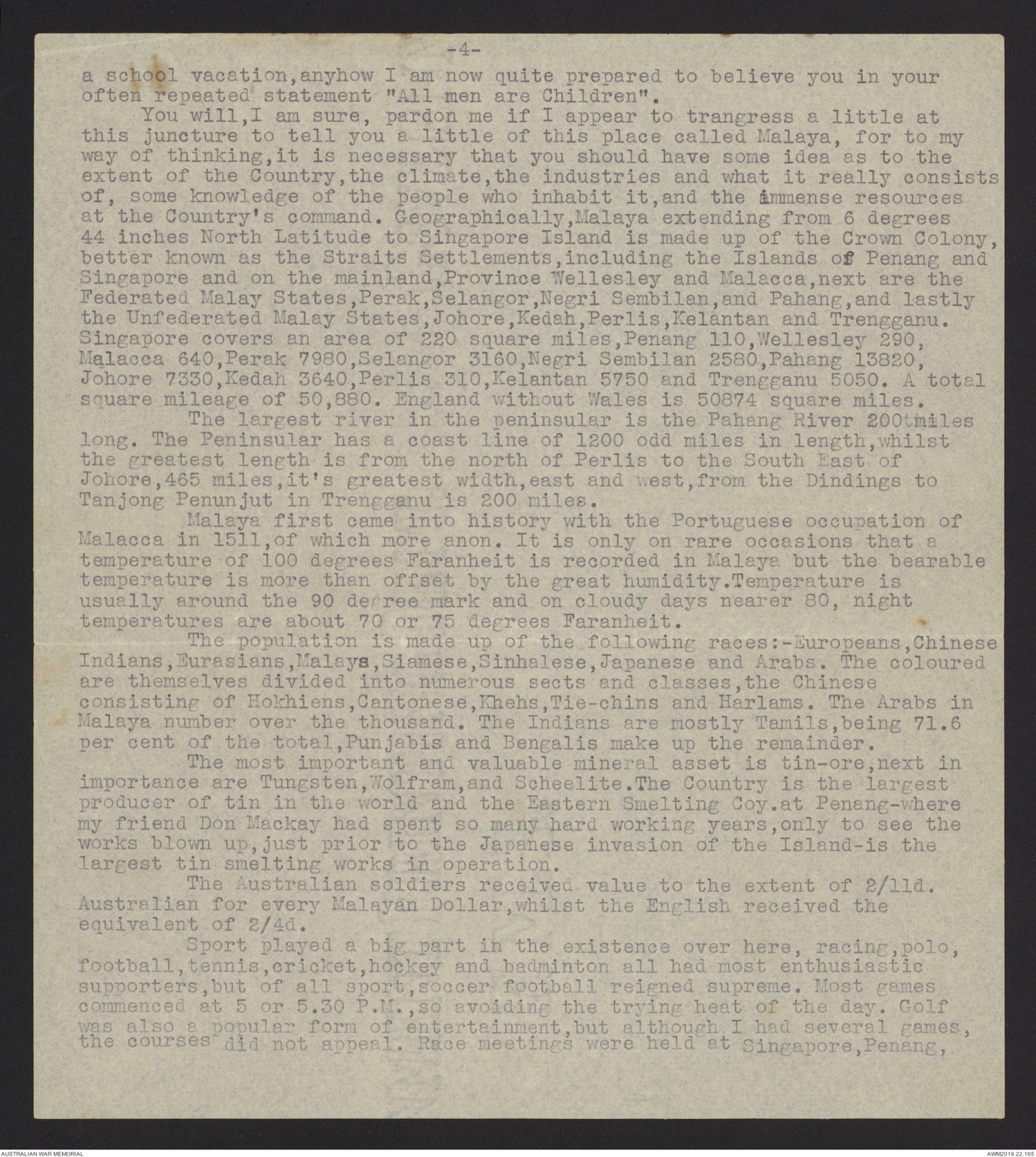
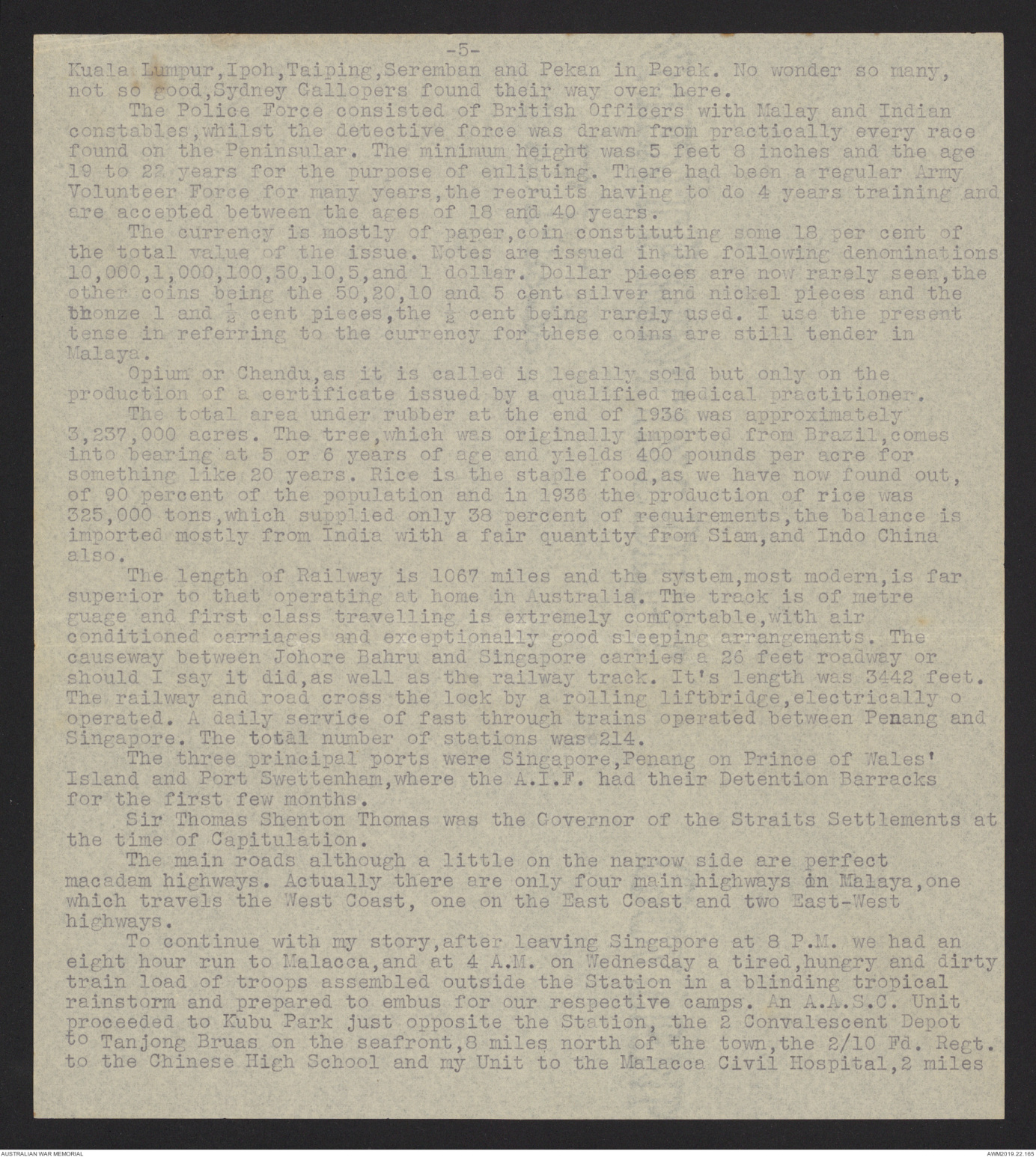
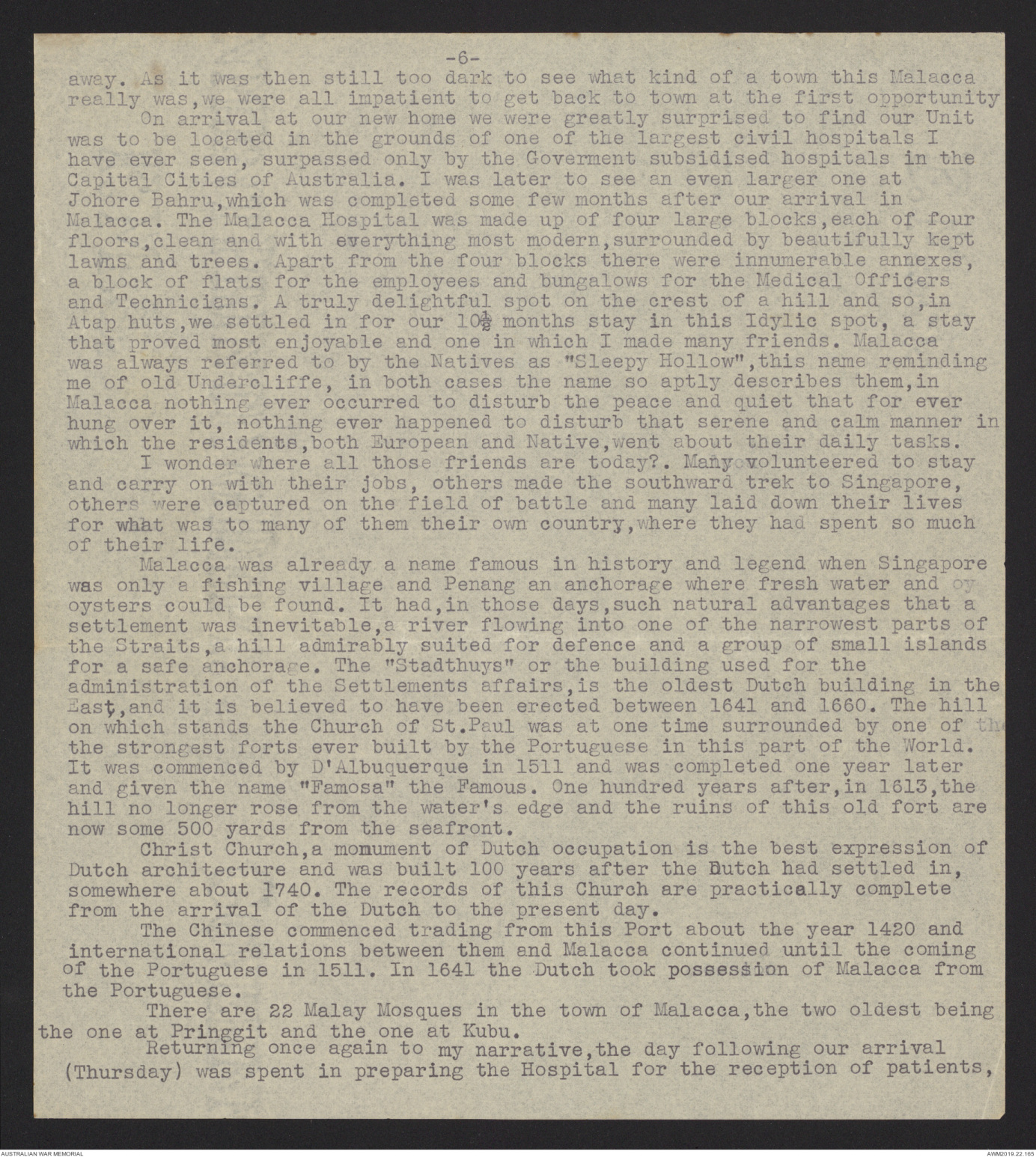

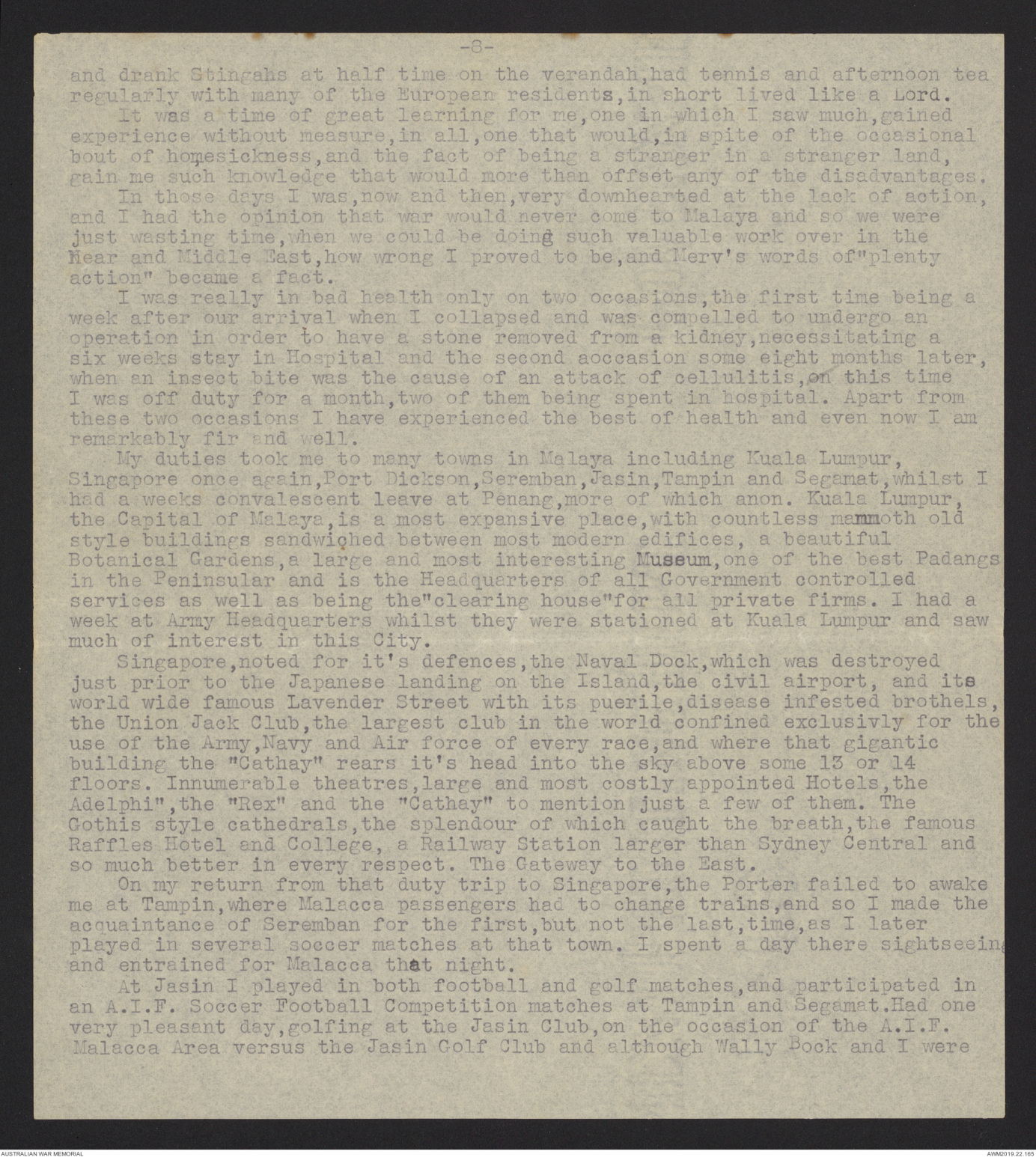
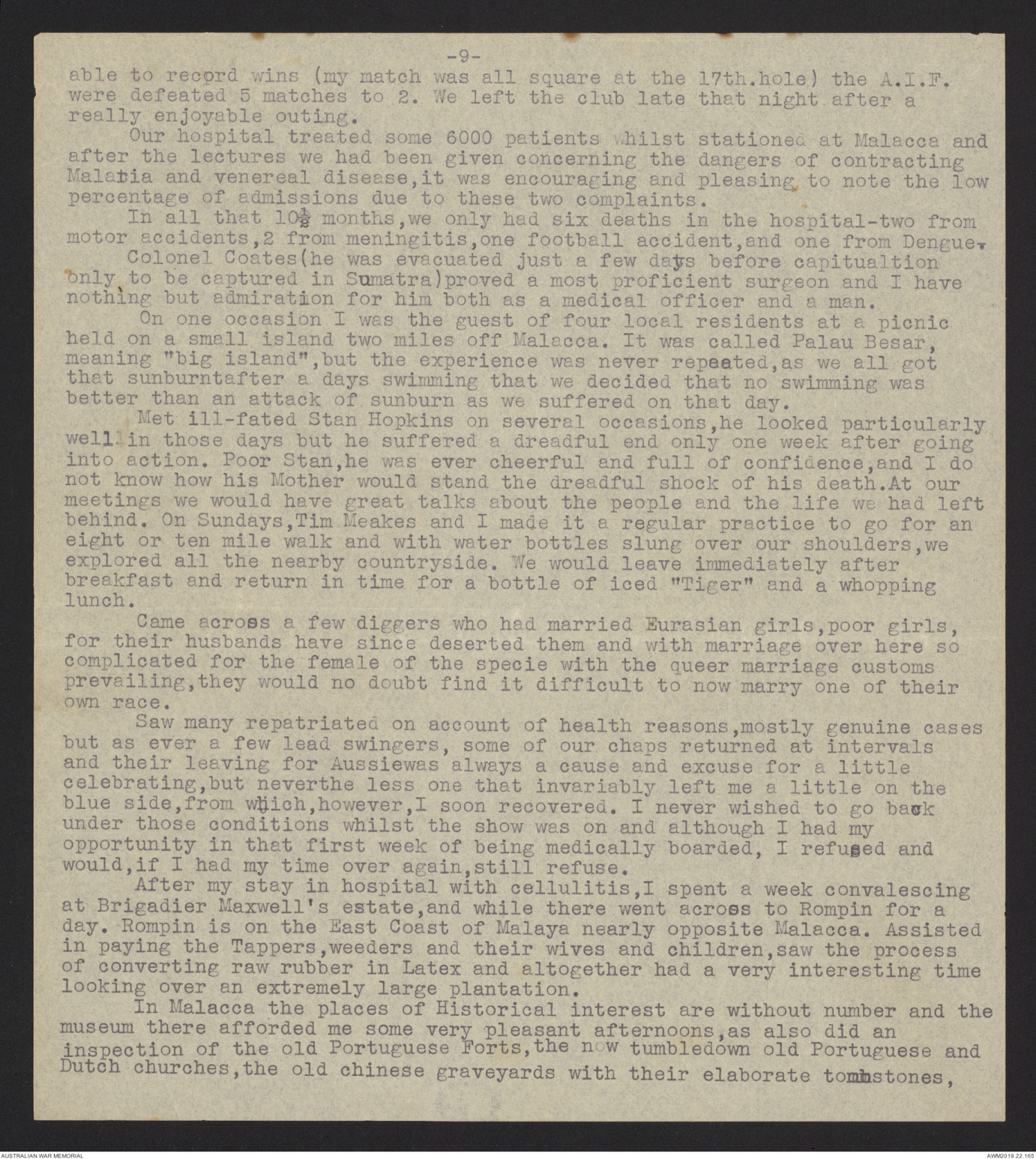
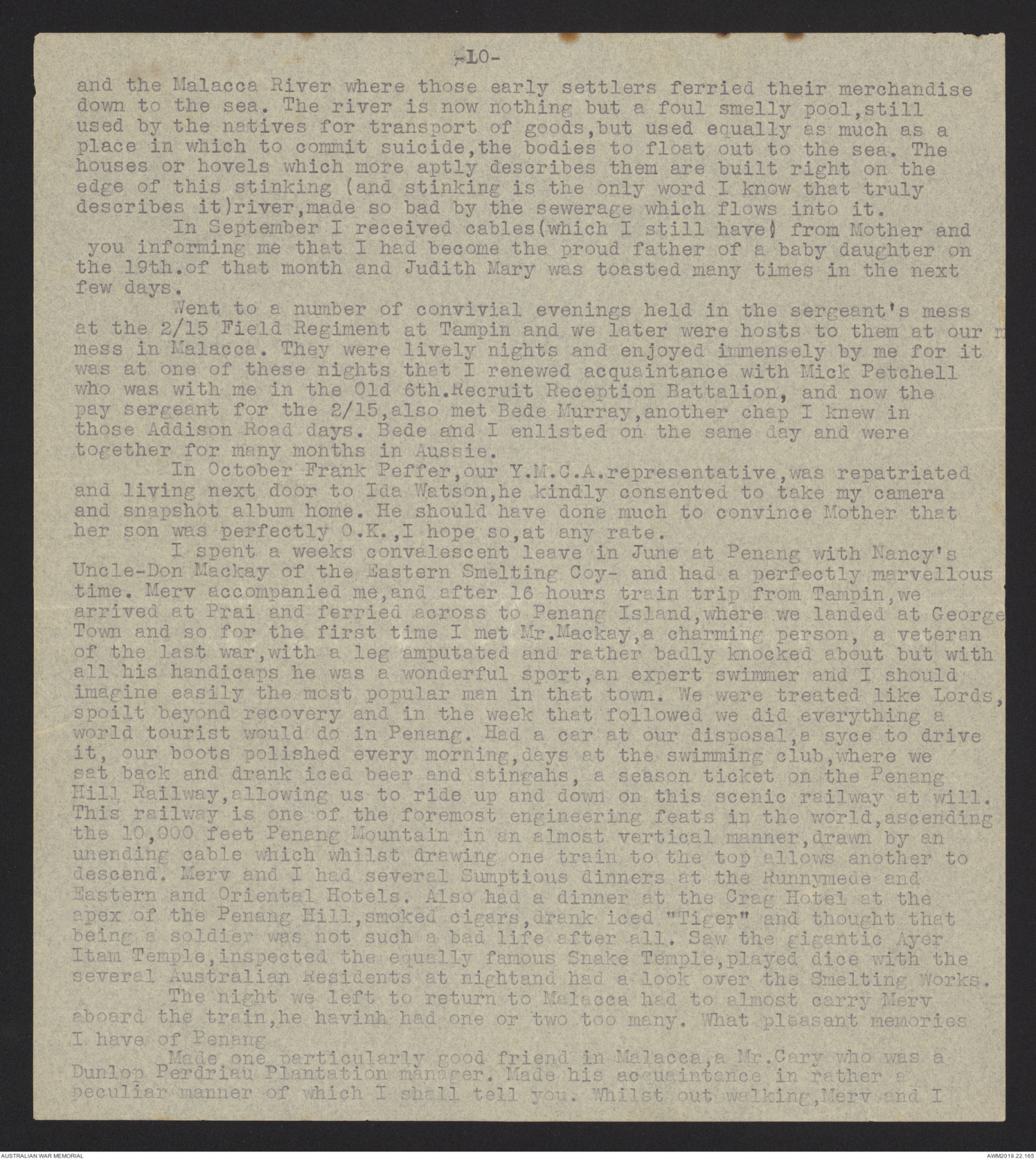
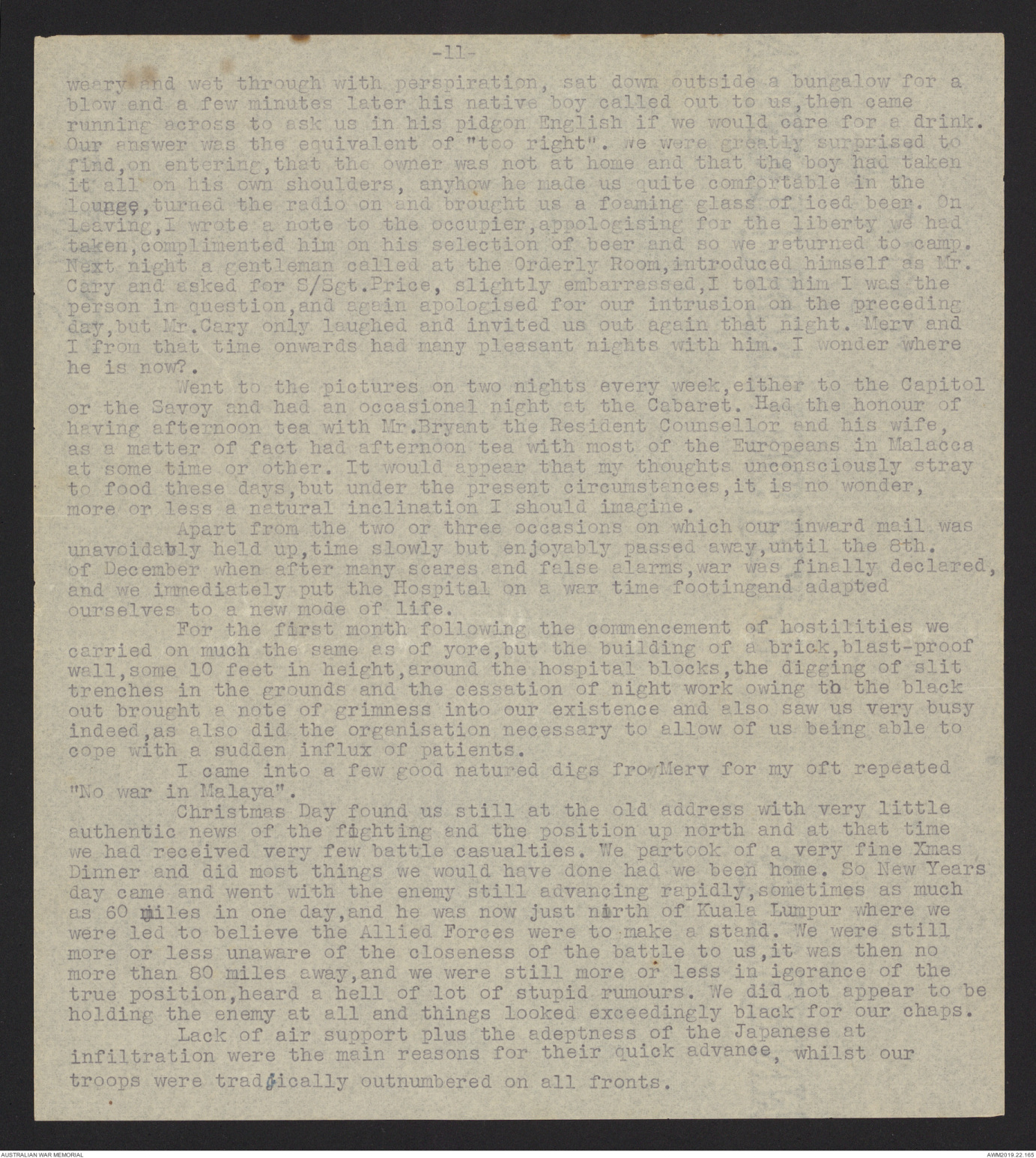
P.O.W. CAMP,
CHANGI, SINGAPORE
14 MAY 42.
My Dear Marion,
After being for the past three months a Prisoner of
War in Malaya,it is with a sudden inspiration and burst of energy-and
believe me energy and concentration are now most difficult attainments
to acquire-that I am sitting down in a determined manner in an effort to
write,or should I say an attempt to record,some of the experiences that
befell one A.I.F. digger serving with an Australian General Hospital in this
tropical country,and the kind of life I have led since saying goodbye to
"Dear Old Sydneytown" on that seemingly so far away 4th. of February 1941
I trust,that although it would not be possible for me to
remember and recall all that has happened since then, I at least can
relate the most important events,particularly those directly concerning
Yours Truly,and that you will find some interest in reading, what is
perhaps a rather disjointed and rambling narrative, yet one that has
afforded me a great deal of enjoyment and pleasure in compiling.
As you had no doubt realised,it was with some difficulty on
my part, that we were able to see each other for the last time on that
ever remembered Saturday afternoon of the 1st.February,and then only for
that very fleeting 20 minutes, made so poignant by the circumstances under
which I found you. No one knows how much I have missed you since.
At that time and for the preceding week, the pressure of work had been
most severe,what with the forming of the Unit, the absence of our Officers
who did not march in until the Friday night,preparations for embarkation,
and the work necessary to give the lads their first pay as members of the
10 Australian General Hospital,S/Sgt. C.L.P. had indeed been a very busy
man.
After leaving you and returning to the Showground Camp for the
last time, the Regimental Sergeant Major and I prepared for a strenuous
nights work and so it proved to be,putting the finishing touches to the
Unit, preparing for a 6 A.M. embussing the following morning and doing
what really seemed a weeks work in one night. During the night one of the
Unit personnel had been arrested by the North Sydney Police and despite
a hurried dash across in a taxi and an attempt to arrange for his release
for embarkation,I was informed that my pleas were to no avail, the charges
apparantly being of too serious a nature to permit of his being freed.
There was a last minute effort to sober a few up which also proved
abortive and the issuing of embarkation tickets. In spite of all obstacles
and the difficulties encountered, we were ready at 5 A.M. and embussed at
5.45 for No. 22 Wharf, Pyrmont. We rode through the gates with the lads
cheering, singing,and laughing-in all a fearful din-and in that manner we
had our last glimpse of the Sydney Agricultural Ground. So began our
big adventure,one that commenced in gladness and ended up in sadness,little
did we dream of what lay ahead of us, and little did we realise what the
future was to bring.
On our journey down to Pyrmont,all kinds of conjectures were
made as to our ultimate destination, at that time I was aware of it,
-2-
but had been instructed not to divulge the information. A few were still
very much under the influence and had to be assisted aboard the ferry which
transorted us across the Harbour to the "Queen Mary", anchored in the Stream
just off Bradley's Head.
Once on board this Giant of the Sea we were shown to our Cabins, I
shared,along with seven others,Cabin No.22 on "B" Deck, and being situated
amidships, it seemed rather a good one. We were just above the water line
with two portholes,two fans,and four air blowers, a bathroom and built-in
lowboy. Then began a period of constantly getting lost on board a ship, a
thing we never overcame for a week, everytime I left our cabin, had the Devils
own job in finding it again. All that day and for the rest of our stay in
Sydney Harbour a stream of Ferries and smaller craft poked their noses
around our Transport. They were packed to overflowingand the soldiers to
the cheering of the occupants, commenced to throw overboard bottles
containing last minute messagesand they were fished out by the sightseers.
In spite of the Naval Patrols endeavours to prevent this practice, it later
developed into a competition,with a maximum of hooting, to see who could
throw one on to the deck of the patrol launches.
My Orderly Room was set up on the Promenade Deck aft on Monday
morning and so the Grindstone claimed me once again.
The occupants of Cabin 22 were S/Sgt.Colin Smyth, S/Sgt. Eric Turner-
later to be known as the "Tamil" S/Sgt. Ron Mackintosk ("Moonface") Sgt. Joe
Martin of Wagga, Sgt. Jack Harding the Pathological Assistant and my close
friend Merv. Laverack also a sergeant, rather an elite gathering.
The first night on board,as on most other nights of the trip across,
Merv and I had two or three beers and then stood on one of the upper decks
leaning over the rail and looking into the night. On this occasion we
turned our gaze to the City lights and wondered how long it would be bfore
we would once again become a part of the City of Sydney. The beers were
partaken of in the Sergeant's Lonnge,located in the Ballroom on "B" Deck
and it was of the best, as was also the food for our 16 days afloat. Excellent
menus of five courses and the appointments aboard were nothing short of
amazing. Spent a few hours on the Monday exploring our temporary home and met
three of Coupland and Waddell's employees, they had been repairing the
degaussing and it cheered me up considerably to see them, took the
opportunity of sending a message ashore per Alic. Griffiths to Gordon.
Our quarters did not prove so good, a little cramped and extremely
close at night when the cabins were sealed, later when approaching the
equator, the heat proved almost unbearable, I slept out in the Alleyway then.
At 2 P.M. on Tuesday 4 February, amidst great excitement,mixed
perhaps with a suspicion of a tear, anchors were weighed, the Battalion
brass bands played "Roll out the Barrel"(The theme song of the A.I.F.)
"The Maoris Farewell" and other appropiate tunes, we slowly moved down the
Harbour followed by the "Aquitania""Mauratania" and the "New Amsterdam" which
later made several troop carrying runs to Singapore, launches played hide and
seek amongst these mannoths of the sea and the slower ferries were soon
dropped astern, the foreshores, particularly South Head,Rose Bay and Vaucluse
-3-
were just a mass of people and to all this we said farewell and slipped
out through the Heads. The Convoy swung Southwards and the H.M.A.S.
Canberra, our esorting warship,picked us up some few miles out.
The trip itself was without incident, a most uneventful journey, hardly
a roll in the ship and I soon up to my ears in work. The monotony of life
was relieved to some extent by the running of a boxing tournament on the
Sun Deck,pictures,concerts,and by the ever popular Australian National
game of"two up", It was always very pleasant, after a hard days work, to
go to one of the Upper Decks after sundown and leaning over the rail,
looking over that wide expanse of blue water was very relaxing, and so
Merv and I would stare at really nothing and day dream for a couple of
hours and not a word would be spoken.
A few days out from Sydney and the "Aquitania" developed minor engine
trouble and was compelled to "hove to",but with our speed reduced to a
extremely slow one, she was able to rejoin the Convoy a few hours later.
Our route took us southward of Tasmania and there we had our only
spell of even cool weather and sweaters were worn, now they are mouldy
and ruined with mildew and somewhere in the bottom of our kit bags.
Across the Bight to Fremantle where we anchored in the stream, just
one week out from Sydney. We were rather unfortunate there as the remaining
ships of the Convoy,owing to their smaller size,were able to berth at the
wharf, so allowing their complements a few hours shore leave. All that we
on the "Queen Mary" saw were many large sharks and on the mainland a big
yellow signboard advertising "Swan Beer". Next morning,the 12th. of Febry.
we proceeded on our way once more and three days later left the Convoy,the
Canberra also detaching herself and being replaced by the H.M.A.S. Durban
This breaking up of the Convoy was a most impressive sight, the "Queen
Mary" or "H.T.Q.X." as we knew her,circled the other three ships,and as
each was passed we gave the lads aboard three cheers, to which they
replied in a like manner, compliments were paid by the running up of flags
by each Commander, and with our speed increased we headed Northwards,whilst
the remainder turned their noses to the West.
On the 18th. of February at 4 P.M. we berthed at Singapore Naval Dock,
after, what was to me,a most interesting trip up the narrow Straits of Johore.
We were immediately instructed to be prepared to disembark the next morning,
but this order was shortly after countermanded and we received orders to be
off the ship at 7 P.M. After a hectic rush in getting patients unloaded and
our own kits packed we marched down the gangway and put our feet on Malaya
for the first time. On the Wharf the Ladies of Singapore kindly gave each
man a few sandwiches and our first bottle of Malayan brewed "Tiger Beer",
which we consumed with great gusto. Then a march of a quarter of a mile to
the Railway Marshalling Yards in the warmest weather (breathing was even a
task) I have ever experienced- I was later told that it was the hottest
spell for twenty years-, and readily believe it.We entrained wet through
with perspiration for Malacca some 190 miles away on the West Coast,packed
150 into a third class carriage built to carry 50 passengers, so what with
gear, perspiration and exhaustion, we,not too comfortably,prepared ourselves
for the long train trip, We hung our soaking wet shirts out the windows to
dry and although dreadfully tired, excited as Schoolchildren starting out on
-4-
a school vacation, anyhow I am now quite prepared to believe you in your
often repeated statement "All men are Children".
You will, I am sure, pardon me if I appear to trangress a little at
this juncture to tell you a little of this place called Malaya, for to my
way of thinking,it is necessary that you should have some idea as to the
extent of the Country,the climate,the industries and what it really consists
of, some knowledge of the people who inhabit it,and the immense resources
at the Country's command. Geographically,Malaya extending from 6 degrees
44 inches North Latitude to Singapore Island is made up of the Crown Colony,
better known as the Straits Settlements,including the Islands of Penang and
Singapore and on the mainland,Province Wellesley and Malacca,next are the
Federated Malay States,Perak,Selangor,Negri Sembilan,and Pahang,and lastly
the Unfederated Malay States,Johore,Kedah,Perlis,Kelantan and Trengganu.
Singapore covers an area of 220 square miles,Penang 110,Wellesley 290,
Malacca 640,Perak 7980,Selangor 3160,Negri Sembilan 2580,Pahang 13820,
Johore 7330,Kedah 3640,Perlis 310,Kelantan 5750 and Trengganu 5050. A total
square mileage of 50,880. England without Wales is 50874 square miles.
The largest river in the peninsular is the Pahang River 260 miles
long. The Peninsular has a coast line of 1200 odd miles in length,whilst
the greatest length is from the north of Perlis to the South East of
Johore,465 miles,it's greatest width,east and west,from the Dindings to
Tanjong Penunjut in Trengganu is 200 miles.
Malaya first came into history with the Portuguese occupation of
Malacca in 1511,of which more anon. It is only on rare occasions that a
temperature of 100 degrees Faranheit is recorded in Malaya but the bearable
temperature is more than offset by the great humidity.Temperature is
usually around the 90 degree mark and on cloudy days nearer 80, night
temperatures are about 70 or 75 degrees Faranheit.
The population is made up of the following races:-Europeans,Chinese
Indians,Eurasians,Malays,Siamese,Sinhalese,Japanese and Arabs. The coloured
are themselves divided into numerous sects and classes,the Chinese
consisting of Hokhiens,Cantonese,Khehs,Tie-chins and Harlams. The Arabs in
Malaya number over the thousand. The Indians are mostly Tamils,being 71.6
per cent of the total,Punjabis and Bengalis make up the remainder.
The most important and valuable mineral asset is tin-ore,next in
importance are Tungsten,Wolfram,and Scheelite. The Country is the largest
producer of tin in the world and the Eastern Smelting Coy.at Penang-where
my friend Don Mackay had spent so many hard working years,only to see the
works blown up, just prior to the Japanese invasion of the Island-is the
largest tin smelting works in operation.
The Australian soldiers received value to the extent of 2/11d.
Australian for every Malayan Dollar,whilst the English received the
equivalent of 2/4d.
Sport played a big part in the existence over here, racing,polo,
football,tennis,cricket,hockey and badminton all had most enthusiastic
supporters,but of all sport,soccer football reigned supreme. Most games
commenced at 5 or 5.30 P.M.,so avoiding the trying heat of the day. Golf
was also a popular form of entertainment,but although I had several games,
the courses did not appeal. Race meetings were held at Singapore,Penang,
-5-
Kuala Lumpur, Ipoh, Taiping, Seremban and Pekan in Perak. No wonder so many,
not so good,Sydney Gallopers found their way over here.
The Police Force consisted of British Officers with Malay and Indian
constables, whilst the detective force was drawn from practically every race
found on the Peninsular. The minimum height was 5 feet 8 inches and the age
19 to 22 years for the purpose of enlisting. There had been a regular Army
Volunteer Force for many years,the recruits having to do 4 years training and
are accepted between the ages of 18 and 40 years.
The currency is mostly of paper,coin constituting some 18 per cent of
the total value of the issue. Notes are issued in the following denominations
10,000,1,000,100,50,10,5,and 1 dollar. Dollar pieces are now rarely seen,the
other coins being the 50,20,10 and 5 cent silver and nickel pieces and the
bronze 1 and ½ cent pieces,the ½ cent being rarely used. I use the present
tense ingreferring to the currency for these coins are still tender in
Malaya.
Opium or Chandu, as it is called is legally sold but only on the
production of a certificate issued by a qualified medical practitioner.
The total area under rubber at the end of 1936 was approximately
3,237,000 acres. The tree,which was originally imported from Brazil,comes
into bearing at 5 or 6 years of age and yields 400 pounds per acre for
something like 20 years. Rice is the staple food,as we have now found out,
of 90 percent of the population and in 1936 the production of rice was
325,000 tons,which supplied only 38 percent of requirements,the balance is
imported mostly from India with a fair quantity from Siam,and Indo China
also.
The length of Railway is 1067 miles and the system,most modern,is far
superior to that operating at home in Australia. The track is of metre
guage and first class travelling is extremely comfortable,with air
conditioned carriages and exceptionally good sleeping arrangements. The
causeway between Johore Bahru and Singapore carries a 26 feet roadway or
should I say it did,as well as the railway track. It's length was 3442 feet.
The railway and road cross the lock by a rolling liftbridge,electrically o
operated. A daily service of fast through trains operated between Penang and
Singapore. The total number of stations was 214.
The three principal ports were Singapore,Penang on Prince of Wales'
Island and Port Swettenham,where the A.I.F. had their Detention Barracks
for the first few months.
Sir Thomas Shenton Thomas was the Governor of the Straits Settlements at
the time of Capitulation.
The main roads although a little on the narrow side are perfect
macadam highways. Actually there are only four mainghighways in Malaya,one
which travels the West Coast, one on the East Coast and two East-West
highways.
To continue with my story,after leaving Singapore at 8 P.M. we had an
eight hour run to Malacca,and at 4 A.M. on Wednesday a tired,hungry and dirty
train load of troops assembled outside the Station in a blinding tropical
rainstorm and prepared to embus for our respective camps. An A.A.S.C. Unit
proceeded to Kubu Park just opposite the Station, the 2 Convalescent Depot
to Tanjong Bruas on the seafront,8 miles north of the town,the 2/10 Fd. Regt.
to the Chinese High School and my Unit to the Malacca Civil Hospital,2 miles
-6-
away. As it was then still too dark to see what kind of a town this Malacca
really was,we were all impatient to get back to town at the first opportunity
On arrival at our new home we were greatly surprised to find our Unit
was to be located in the grounds of one of the largest civil hospitals I
have ever seen, surpassed only by the Goverment subsidised hospitals in the
Capital Cities of Australia. I was later to see an even larger one at
Johore Bahru, which was completed some few months after our arrival in
Malacca. The Malacca Hospital was made up of four large blocks,each of four
floors,clean and with everything most modern,surrounded by beautifully kept
lawns and trees. Apart from the four blocks there were innumerable annexes,
a block of flats for the employees and bungalows for the Medical Officers
and Technicians. A truly delightful spot on the crest of a hill and so,in
Atap huts, we settled in for our 10½ months stay in this Idylic spot, a stay
that proved most enjoyable and one in which I made many friends. Malacca
was always referred to by the Natives as "Sleepy Hollow",this name reminding
me of old Undercliffe, in both cases the name so aptly describes them,in
Malacca nothing ever occurred to disturb the peace and quiet that for ever
hung over it, nothing ever happened to disturb that serene and calm manner in
which the residents,both European and Native,went about their daily tasks.
I wonder where all those friends are today?. Many volunteered to stay
and carry on with their jobs, others made the southward trek to Singapore,
others were captured on the field of battle and many laid down their lives
for what was to many of them their own country,where they had spent so much
of their life.
Malacca was already a name famous in history and legend when Singapore
was only a fishing village and Penang an anchorage where fresh water and
oysters could be found. It had,in those days,such natural advantages that a
settlement was inevitable,a river flowing into one of the narrowest parts of
the Straits,a hill admirably suited for defence and a group of small islands
for a safe anchorage. The "Stadthuys" or the building used for the
administration of the Settlements affairs,is the oldest Dutch building in the
East,and it is believed to have been erected between 1641 and 1660. The hill
on which stands the Church of St.Paul was at one time surrounded by one of
the strongest forts ever built by the Portuguese in this part of the World.
It was commenced by D'Albuquerque in 1511 and was completed one year later
and given the name "Famosa" the Famous. One hundred years after, in 1613,the
hill no longer rose from the water's edge and the ruins of this old fort are
now some 500 yards from the seafront.
Christ Church,a momument of Dutch occupation is the best expression of
Dutch architecture and was built 100 years after the Dutch had settled in,
somewhere about 1740. The records of this Church are practically complete
from the arrival of the Dutch to the present day.
The Chinese commenced trading from this Port about the year 1420 and
international relations between them and Malacca continued until the coming
of the Portuguese in 1511. In 1641 the Dutch took possession of Malacca from
the Portuguese.
There are 22 Malay Mosques in the town of Malacca,the two oldest being
the one at Pringgit and the one at Kubu.
Returning once again to my narrative,the day following our arrival
(Thursday) was spent in preparing the Hospital for the reception of patients,
-7-
and making our own quarters as comfortable as possible, we also made the
very galling discovery that owing to some hitch or other,the army issue of
rations for the first few days would be extremely light, not very pleasant
news after our sumptious fare on the trip over and the healthy appetites
we had gained in the new surroundings. Fortunately for us,the Civil Hospital
tuckshop was able to supply us with English and Australian Biscuits and
chocolate with which we were well able to appease our hunger. Late that
afternoon,Merv and I sneaked in to have a look over the town, a large one
extending right to the waters edge where the Straits of Malacca,as far out
as the eye could see,appeared very dirty and shallow, it seemed no more than
a few feet in depth, we were later to find that it was indeed anything but
deep within half a mile of the shore but of course very deep after that.
It was a Town of awful stench so peculiar to all Malayan cities, towns,
kampongs and villages, yet within a month we came not to notice this smell.
Children flock around us with calls of "Hullo Jo" few wore clothes,
and were just as cheeky as any I have run across in Aussie, but the adult
natives for many days after our arrival ran for dear life on our approach
and even took the precaution of locking their woman folk behind doors. One
of the Chinese nurses at the Civil Hospital later told me that the natives
had been told by some mischief maker that their woman would not be safe
and their own lives would not be worth twopence if we took it into our heads
to get amongst them. How soon they got over their fear, and how they robbed
us of our dollars.
It was a place to see Indians intermingling with Chinese and Malays
with Eurasians and the English kept as aloof as ever. Three theatres-two
showing European pictures and the other Tamil-,a cabaret, an amusement park
known as City Park,many hotels and a government rest house supplied the
recreation and entertainment for the A.I.F. in that town, and we all came
to depend on relaxation and recreation so much with the monotony of things
as months slowly winged their way onwards.
Malacca was mostly a slum area but there were at the same time some
ultra modern European Godowns (warehouses)and shops. The European Bungalows
were indeed the acme of comfort and beauty,palatial dwellings in spacious
well kept grounds. In the town Taxis vied with Gharrys drawn by the thinnest
ponies I have ever seen,how they managed to stand up let alone pull the
carriage was always a source of amazement to me , rickshaws in competition
with omnibuses, everything a paradox, but with all a place of interest
and attraction. Each and every native seemed to quickly awake to the fact
that the Australians were a source of easy and quick money and they soon
commenced to go to work on us, so much so that on that first trip to town,
we were charged 1 dollar by the rickshaw puller for what afterwards cost us
20 to 30 cents,depending on the mood we werein.
The cabaret girls were a novel feature to us, four dances for one
dollar, but they were,without doubt,beautiful dancers,as were also the
native men. The girls were mostly Chinese and only modern dances,with the
exception of that ever popular Malayan dance the Krongchong, were the order
of the day.
During my stay in Malacca I played in as many as three Soccer matches
a week,never less than two,played cricket on the Padang at the Rest House
-8-
and drank Stingahs at half time on the verandah,had tennis and afternoon tea
regularly with many of the European residents,in short lived like a Lord.
It was a time of great learning for me,one in which I saw much, gained
experience without measure,in all,one that would,in spite of the occasional
bout of homesickness,and the fact of being a stranger in a stranger land,
gain me such knowledge that would more than offset any of the disadvantages.
In those days I was,now and then,very downhearted at the lack of action,
and I had the opinion that war would never come to Malaya and so we were
just wasting time,when we could be doing such valuable work over in the
Near and Middle East,how wrong I proved to be,and Merv's words of"plenty
action" became a fact.
I was really in bad health only on two occasions,the first time being a
week after our arrival when I collapsed and was compelled to undergo an
operation in order to have a stone removed from a kidney,necessitating a
six weeks stay in Hospital and the second aoccasion some eight months later,
when an insect bite was the cause of an attack of cellulitis,on this time
I was off duty for a month,two of them being spent in hospital. Apart from
these two occasions I have experienced the best of health and even now I am
remarkably fir and well.
My duties took me to many towns in Malaya including Kuala Lumpur,
Singapore once again,Port Dickson,Seremban,Jasin,Tampin and Segamat,whilst I
had a weeks convalescent leave at Penang,more of which anon. Kuala Lumpur,
the Capital of Malaya,is a most expansive place,with countless mammoth old
style buildings sandwiched between most modern edifices, a beautiful
Botanical Gardens,a large and most interesting Museum,one of the best Padangs
in the Peninsular and is the Headquarters of all Government controlled
services as well as being the"clearing house "for all private firms. I had a
week at Army Headquarters whilst they were stationed at Kuala Lumpur and saw
much of interest in this City.
Singapore,noted for it's defences,the Naval Dock,which was destroyed
just prior to the Japanese landing on the Island,the civil airport, and its
world wide famous Lavender Street with its puerile,disease infested brothels,
the Union Jack Club,the largest club in the world confined exclusivly for the
use of the Army,Navy and Air force of every race,and where that gigantic
building the "Cathay" rears it's head into the sky above some 13 or 14
floors. Innumerable theatres,large and most costly appointed Hotels,the
Adelphi" , the "Rex" and the "Cathay" to mention just a few of them. The
Gothis style cathedrals,the splendour of which caught the breath,the famous
Raffles Hotel and College, a Railway Station larger than Sydney Central and
so much better in every respect. The Gateway to the East.
On my return from that duty trip to Singapore,the Porter failed to awake
me at Tampin,where Malacca passengers had to change trains,and so I made the
acquaintance of Seremban for the first,but not the last,time as I later
played in several soccer matches at that town. I spent a day there sightseeing
and entrained for Malacca that night.
At Jasin I played in both football and golf matches,and participated in
an A.I.F. Soccer Football Competition matches at Tampin and Segamat.Had one
very pleasant day,golfing at the Jasin Club,on the occasion of the A.I.F.
Malacca Area versus the Jasin Golf Club and although Wally Bock and I were
-9-
able to record wins (my match was all square at the 17th.hole) the A.I.F.
were defeated 5 matches to 2. We left the club late that night after a
really enjoyable outing.
Our hospital treated some 6000 patients whilst stationed at Malacca and
after the lectures we had been given concerning the dangers of contracting
Malaria and venereal disease,it was encouraging and pleasing to note the low
percentage of admissions due to these two complaints.
In all that 10½ months,we only had six deaths in the hospital-two from
motor accidents,2 from meningitis,one football accident,and one from Dengue.
Colonel Coates(he was evacuated just a few days before capitualtion
only to be captured in Sumatra)proved a most proficient surgeon and I have
nothing but admiration for him both as a medical officer and a man.
On one occasion I was the guest of four local residents at a picnic
held on a small island two miles off Malacca. It was called Palau Besar,
meaning "big island",but the experience was never repeated,as we all got
that sunburntafter a days swimming that we decided that no swimming was
better than an attack of sunburn as we suffered on that day.
Met ill-fated Stan Hopkins on several occasions,he looked particularly
well in those days but he suffered a dreadful end only one week after going
into action. Poor Stan,he was ever cheerful and full of confidence,and I do
not know how his Mother would stand the dreadful shock of his death.At our
meetings we would have great talks about the people and the life we had left
behind. On Sundays,Tim Meakes and I made it a regular practice to go for an
eight or ten mile walk and with water bottles slung over our shoulders,we
explored all the nearby countryside. We would leave immediately after
breakfast and return in time for a bottle of iced "Tiger" and a whopping
lunch.
Came across a few diggers who had married Eurasian girls,poor girls,
for their husbands have since deserted them and with marriage over here so
complicated for the female of the specie with the queer marriage customs
prevailing,they would no doubt find it difficult to now marry one of their
own race.
Saw many repatriated on account of health reasons,mostly genuine cases
but as ever a few lead swingers, some of our chaps returned at intervals
and their leaving for Aussiewas always a cause and excuse for a little
celebrating,but neverthe less one that invariably left me a little on the
blue side,from which,however,I soon recovered. I never wished to go back
under those conditions whilst the show was on and although I had my
opportunity in that first week of being medically boarded, I refused and
would,if I had my time over again,still refuse.
After my stay in hospital with cellulitis,I spent a week convalescing
at Brigadier Maxwell's estate,and while there went across to Rompin for a
day. Rompin is on the East Coast of Malaya nearly opposite Malacca. Assisted
in paying the Tappers,weeders and their wives and children,saw the process
of converting raw rubber in Latex and altogether had a very interesting time
looking over an extremely large plantation.
In Malacca the places of Historical interest are without number and the
museum there afforded me some very pleasant afternoons,as also did an
inspection of the old Portuguese Forts,the now tumbledown old Portuguese and
Dutch churches,the old chinese graveyards with their elaborate tombstones,
-10-
and the Malacca River where those early settlers ferried their merchandise
down to the sea. The river is now nothing but a foul smelly pool,still
used by the natives for transport of goods,but used equally as much as a
place in which to commit suicide,the bodies to float out to the sea. The
houses or hovels which more aptly describes them are built right on the
edge of this stinking (and stinking is the only word I know that truly
describes it)river,made so bad by the sewerage which flows into it.
In September I received cables(which I still have) from Mother and
you informing me that I had become the proud father of a baby daughter on
the 19th.of that month and Judith Mary was toasted many times in the next
few days.
Went to a number of convivial evenings held in the sergeant's mess
at the 2/15 Field Regiment at Tampin and we later were hosts to them at our
mess in Malacca. They were lively nights and enjoyed immensely by me for it
was at one of these nights that I renewed acquaintance with Mick Petchell
who was with me in the Old 6th.Recruit Reception Battalion, and now the
pay sergeant for the 2/15,also met Bede Murray,another chap I knew in
those Addison Road days. Bede and I enlisted on the same day and were
together for many months in Aussie.
In October Frank Peffer,our Y.M.C.A.representative,was repatriated
and living next door to Ida Watson,he kindly consented to take my camera
and snapshot album home. He should have done much to convince Mother that
her son was perfectly O.K.,I hope so,at any rate.
I spent a weeks convalescent leave in June at Penang with Nancy's
Uncle-Don Mackay of the Eastern Smelting Coy- and had a perfectly marvellous
time. Merv accompanied me,and after 16 hours train trip from Tampin,we
arrived at Prai and ferried across to Penang Island,where we landed at George
Town and so for the first time I met Mr.Mackay,a charming person, a veteran
of the last war,with a leg amputated and rather badly knocked about but with
all his handicaps he was a wonderful sport,an expert swimmer and I should
imagine easily the most popular man in that town. We were treated like Lords,
spoilt beyond recovery and in the week that followed we did everything a
world tourist would do in Penang. Had a car at our disposal,a syce to drive
it, our boots polished every morning,days at the swimming club,where we
sat back and drank iced beer and stingahs, a season ticket on the Penang
Hill Railway,allowing us to ride up and down on this scenic railway at will.
This railway is one of the foremost engineering feats in the world,ascending
the 10,000 feet Penang Mountain in an almost vertical manner,drawn by an
unending cable which whilst drawing one train to the top allows another to
descend. Merv and I had several Sumptious dinners at the Runnymede and
Eastern and Oriental Hotels. Also had a dinner at the Crag Hotel at the
apex of the Penang Hill,smoked cigars,drank iced "Tiger" and thought that
being a soldier was not such a bad life after all. Saw the gigantic Ayer
Itam Temple,inspected the equally famous Snake Temple,played dice with the
several Australian Residents at nightand had a look over the Smelting Works.
The night we left to return to Malacca had to almost carry Merv
aboard the train,he havinh had one or two too many. What pleasant memories
I have of Penang
Made one particularly good friend in Malacca, a Mr.Cary who was a
Dunlop Perdriau Plantation manager. Made his acquaintance in rather a
peculiar manner of which I shall tell you. Whilst out walking,Merv and I
-11-
weary and wet through with perspiration, sat down outside a bungalow for a
blow and a few minutes later his native boy called out to us,then came
running across to ask us in his pidgon English if we would care for a drink.
Our answer was the equivalent of "too right". We were greatly surprised to
find,on entering,that the owner was not at home and that the boy had taken
it all on his own shoulders, anyhow he made us quite comfortable in the
lounge,turned the radio on and brought us a foaming glass of iced beer. On
leaving,I wrote a note to the occupier, appologising for the liberty we had
taken,complimented him on his selection of beer and so we returned to camp.
Next night a gentleman called at the Orderly Room,introduced himself as Mr.
Cary and asked for S/Sgt.Price, slightly embarrassed,I told him I was the
person in question,and again apologised for our intrusion on the preceding
day,but Mr.Cary only laughed and invited us out again that night. Merv and
I from that time onwards had many pleasant nights with him. I wonder where
he is now?.
Went to the pictures on two nights every week,either to the Capitol
or the Savoy and had an occasional night at the Cabaret. Had the honour of
having afternoon tea with Mr.Bryant the Resident Counsellor and his wife,
as a matter of fact had afternoon tea with most of the Europeans in Malacca
at some time or other. It would appear that my thoughts unconsciously stray
to food these days,but under the present circumstances,it is no wonder,
more or less a natural inclination I should imagine.
Apart from the two or three occasions on which our inward mail was
unavoidably held up,time slowly but enjoyably passed away,until the 8th.
of December when after many scares and false alarms,war was finally declared,
and we immediately put the Hospital on a war time footingand adapted
ourselves to a new mode of life.
For the first month following the commencement of hostilities we
carried on much the same as of yore,but the building of a brick,blast-proof
wall, some 10 feet in height, around the hospital blocks,the digging of slit
trenches in the grounds and the cessation of night work owing to the black
out brought a note of grimness into our existence and also saw us very busy
indeed,as also did the organisation necessary to allow of us being able to
cope with a sudden influx of patients.
I came into a few good natured digs from Merv for my oft repeated
"No war in Malaya".
Christmas Day found us still at the old address with very little
authentic news of the fighting and the position up north and at that time
we had received very few battle casualties. We partook of a very fine Xmas
Dinner and did most things we would have done had we been home. So New Years
day came and went with the enemy still advancing rapidly,sometimes as much
as 60 miles in one day,and he was now just north of Kuala Lumpur where we
were led to believe the Allied Forces were to make a stand. We were still
more or less unaware of the closeness of the battle to us,it was then no
more than 80 miles away,and we were still more or less in igorance of the
true position,heard a hell of lot of stupid rumours. We did not appear to be
holding the enemy at all and things looked exceedingly black for our chaps.
Lack of air support plus the adeptness of the Japanese at
infiltration were the main reasons for their quick advance, whilst our
troops were tradgically outnumbered on all fronts.
 Jacqueline Kennedy
Jacqueline KennedyThis transcription item is now locked to you for editing. To release the lock either Save your changes or Cancel.
This lock will be automatically released after 60 minutes of inactivity.